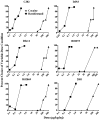Self-administration of cocaine and remifentanil by monkeys: choice between single drugs and mixtures
- PMID: 21191570
- PMCID: PMC3107981
- DOI: 10.1007/s00213-010-2131-1
Self-administration of cocaine and remifentanil by monkeys: choice between single drugs and mixtures
Abstract
Rationale: Cocaine and opioids are often co-abused. As yet, however, there is no clear evidence that the drugs interact to make the mixture a more effective reinforcer.
Objective: The present study examined the relative reinforcing potency and maximum effectiveness of the cocaine-opioid combination in monkeys given a choice between cocaine-opioid mixtures and the single-component drugs.
Method: Rhesus monkeys were allowed to choose between injections of cocaine (100 μg/kg/inj) and other doses of cocaine (10-560 μg/kg/inj) or remifentanil (0.03-3.0 μg/kg/inj). A dose-addition model was used to select dose combinations for mixtures of cocaine and remifentanil predicted to be equivalent to 100 μg/kg/inj of cocaine in reinforcing effect if the drugs were additive. The monkeys were then allowed to choose between (a) cocaine and mixtures predicted to be equivalent to 100 μg/kg/inj of cocaine, (b) increasing doses of the mixtures and the single-component drugs, and (c) cocaine or remifentanil at doses that were in the highest safe range.
Results: Generally, monkeys preferred the mixtures over 100 μg/kg/inj of cocaine, evidence for superadditivity. However, preferences for the mixture ceased when relatively high doses of single-component drugs were offered as alternatives. When doses within the mixture were raised and offered with relatively high doses of the single drugs, there was no clear preference for either option. The highest dose of remifentanil was chosen over the highest dose of cocaine by all monkeys.
Conclusion: The current results indicate that cocaine-opioid combinations can be super-additive in terms of potency, but are not, at maximum, more effective than the single-component drugs.
Conflict of interest statement
The authors have no conflicts of interest to disclose.
Figures




References
-
- Arnold JM, Roberts DCS. A critique of fixed and progressive ratio schedules used to examine the neural substrates of drug reinforcement. Pharmacol Biochem Behav. 1997;57:441–447. - PubMed
-
- Bickel WK, DeGrandpre RJ, Higgins ST. Behavioral economics: a novel experimental approach to the study of drug dependence. Drug Alcohol Depend. 1993;33:173–192. - PubMed
-
- Coffin PO, Galea S, Ahem J, Leon AC, Vlahov D, Tardiff K. Opiates, cocaine and alcohol combinations in accidental drug overdose deaths in New York City, 1990–1998. Addiction. 2003;98:739–747. - PubMed
-
- Downey KK, Helmus TC, Schuster CR. Treatment of heroin-dependent polydrug abusers with contingency management and buprenorphine maintenance. Exp Clin Psychopharmacol. 2000;8:176–184. - PubMed
Publication types
MeSH terms
Substances
Grants and funding
LinkOut - more resources
Full Text Sources
Research Materials

